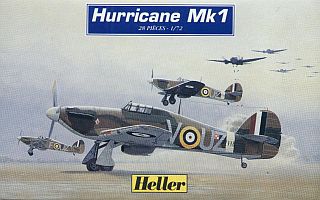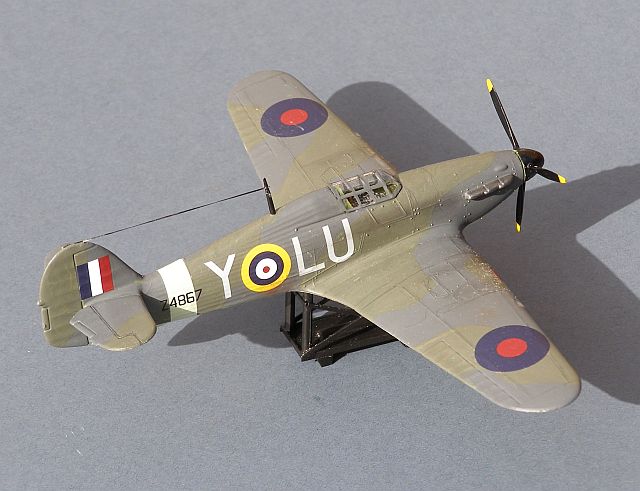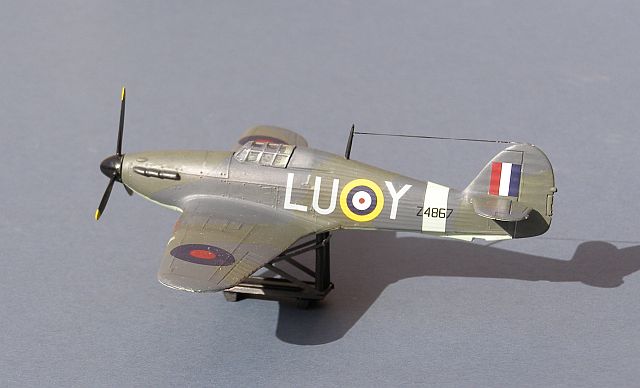December 2009
Hawker
Sea Hurricane 1A "Hurricat" DeHavilland Sea Hornet F.20![]()
![]() This
Month's significant WW2 Anniversaries:
This
Month's significant WW2 Anniversaries:
13 Dec 1939 -
Battle of the River Plate. Royal Navy South Atlantic Squadron corners
the pocket Battleship Graf Spee in Montivideo. Graf Spee scuttled on
17 Dec.
20 Dec 1939 - 1st
Lothians & Borders Yeomanry begins pre-embarkation leave from
Tidworth Barracks. The Regiment, as part of the 48th Division,
would become the first British Cavalry unit to go to France. The 48th
Division was also the first British Territorial Division to be
deployed overseas.
Hawker Sea Hurricane Mk.1A "Hurricat", Fleet Air Arm Merchant Ship Fighter Unit, RAF Speke, 1941.
Heller (Airfix) 1/72, with Aeromaster transfers & scratch catapult trolley.
It would be remiss to end this 100th anniversary year of British Naval Aviation, without including one of the most amazing naval aircraft concepts ever deployed. With the growing losses of merchant ships to Focke-Wulf Fw200 Condor attacks and a desperate shortage of aircraft carriers, the Admiralty decided to fit selected merchant vessels with a rocket powered catapult, enabling them to launch their own Hurricane fighter, as a last ditch defence should a convoy come under air attack.

The drawback to this otherwise promising concept was the lack of any landing or recovery facilities; after they had destroyed or driven off the attacking Condor, pilots were expected to make for the nearest land, or to ditch alongside their ship and hope that they would be rescued! The aircraft were drawn from ex-RAF stocks (mostly Battle of Britain veterans), given a simple conversion to become a Sea Hurricane Mk 1A. It was a desperate measure, carrying a lot of personal risk; the aircraft were flown by special Fleet Air Arm and RAF volunteers. Although it only lasted for a short period, the Hurricat concept was a modest success, helping to sustain the vital North Atlantic and Arctic convoys through the darkest days of 1941.

My base kit is the nice (if basic) Airfix Hurricane Mk.1, in this case issued by Heller. With the exception of a slightly too skinny nose and strangely shaped propellers, this is a good little kit that builds well and looks correct when complete. It has no real assembly issues, although I did need a little filler on the starboard wing root, and I built in a simple undercarriage bay roof. The kit's propeller blades were of too wide a chord for this aircraft, so I have replaced them with some spare ones from (I think) a HobbyBoss Hurricane.

The catapult trolley is based on some very rough photographs, so I make no claims to accuracy; indeed I think it is probably too narrow, but it makes the point.

Decals come from the excellent Aeromaster "Fleet Air Arm Part 1" set (which Hannants had on offer in September), for an aircraft on the books of 9 Group RAF.

More Hurricanes and Sea Hurricanes on the RN Props pages
De Havilland Sea Hornet F.20, 801 Sqn Fleet Air Arm, HMS IMPLACABLE, 1950.
Frog/Novo 1/72 Hornet, with scratch modification and decals for SeaHornet.
The elegant Sea Hornet is surely one of the most attractive aircraft designs ever to serve at sea. With its lightweight wooden construction and twin Merlin engines (rotating in opposite directions), it possessed exceptional maneoeverability and represented a worthy single seat fighter development of DeHavilland's famous Mosquito.
The raw materials on the bench
Frog's kit, in this case an early Novo issue, is another excellent example of late Frog quality. Certainly, it is basic, but it fits together well (even in this Novo incarnation) and is reasonably accurate. The very few panel lines are raised and perhaps a little heavy, whilst comparison with a set of basic drawings suggests that the nose may be a little too short, but overall the kit captures the shape of this now extinct aircraft well enough.
New hook added to the after fuselage
I have taken a fairly simple approach to converting mine into a Sea Hornet; basically an A-frame hook, some cockpit radio boxes and new decals. The real thing had a different undercarriage arrangement from the land based fighter, with long stroke pneumatic oleos instead of compressed rubber bumpers, but at 1/72 scale there is little to see.
The hook in its raw state. After a light sanding down, it blended in very nicely.
My main area of attention has been the canopy - it was missing from this cheapy e-bay purchase (how often have I heard that), so the one you see here is a modified Sea Fury after end, with a Hunter windscreen.
Starting to look like the end product! Panel lines and wing folds were drawn on in pencil, then a light oil was was applied to give depth
And here we are with the completed model. It is certainly not to competition standard, nor would it stand up to detailed scrutiny from a Sea Hornet expert, but this is exactly the sort of modelling that I enjoy the most. Quick, cheap, a simple scratch built change from what was in the box, and it certainly looks good enough for my purposes !
More post-war RN prop aircraft on the RN Props pages
.... And what a satisfying way to end a bumper year of model building. Best wishes to one and all, and happy modelling in 2010!
FredT
www.gengriz.co.uk